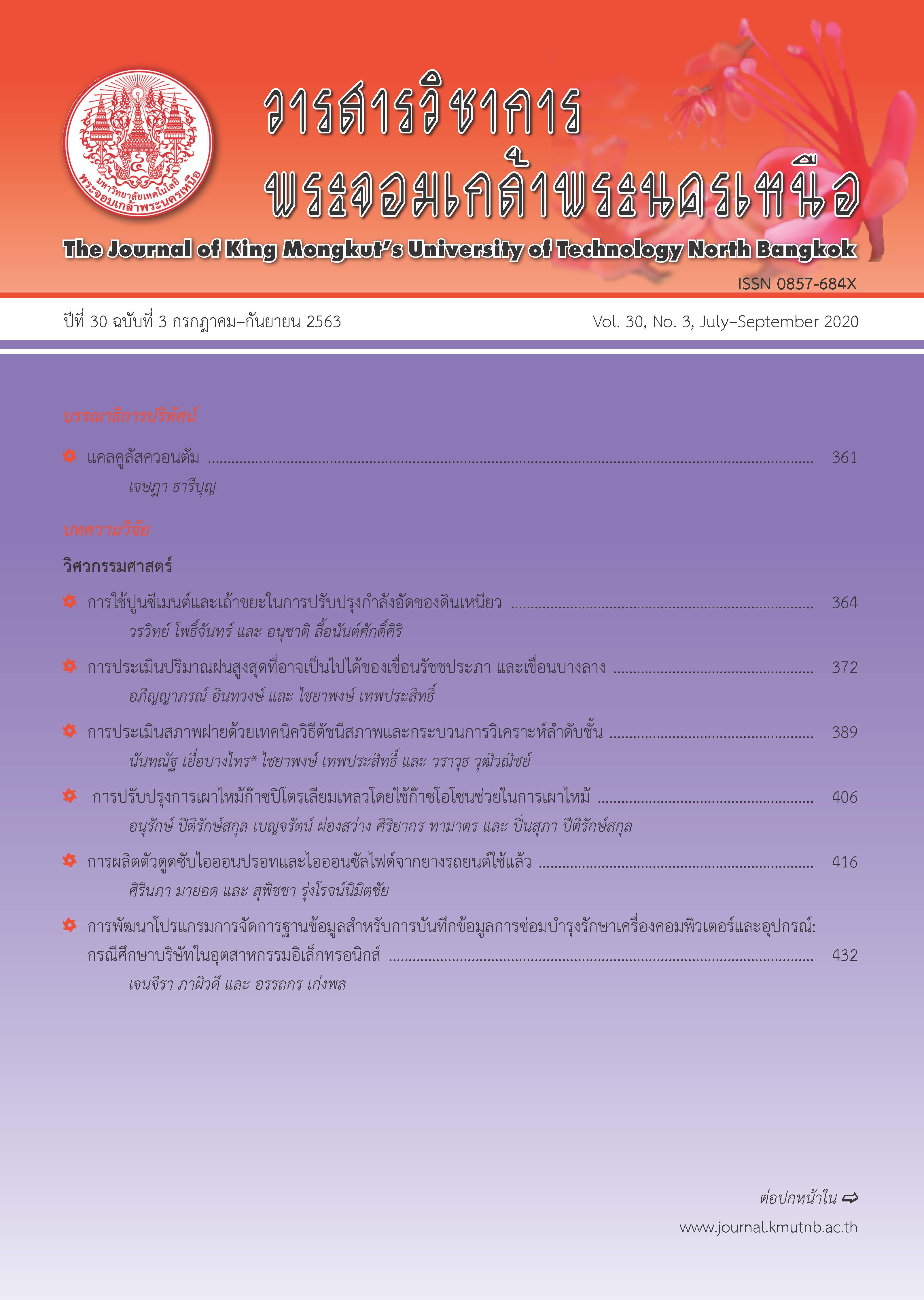ผลกระทบของกรรมวิธีการเชื่อมเสียดทานวัสดุต่างชนิดต่อโครงสร้างทางโลหะวิทยาและสมบัติ ทางกลระหว่างอะลูมิเนียมหล่อกึ่งของแข็ง SSM 356 กับ SSM 7075 โดยมีชั้นทองแดงเป็น วัสดุเสริมในแนวเชื่อม
Main Article Content
บทคัดย่อ
งานวิจัยครั้งนี้ศึกษาการเชื่อมเสียดทานอะลูมิเนียมหล่อกึ่งของแข็งต่างชนิดระหว่าง SSM 356 กับ SSM 7075 ที่มีขนาดเส้นผ่านศูนย์กลาง 10 มิลลิเมตร และมีความยาว 100 มิลลิเมตร ภายใต้ความเร็วหมุนเชื่อม 1,300 รอบต่อนาที แรงดันเสียดทาน 50 บาร์ แรงดันอัด 3 ระดับ คือ 10, 20 และ 30 บาร์ เวลาเสียดทาน 30 วินาที และเวลาดันอัด 3 ระดับ คือ 5, 7 และ 10 วินาที เพื่อศึกษาปัจจัยของการเชื่อมที่ส่งผลกระทบต่อโครงสร้างมหภาค โครงสร้างจุลภาค และสมบัติทางกล ผลการทดลองพบว่าความเร็วหมุนเชื่อม แรงดันอัด และเวลาดันอัด ส่งผลโดยตรงต่อการเกิดครีบของแนวเชื่อมเมื่อเพิ่มแรงดันอัดและเวลาดันอัดมากขึ้นส่งผลให้ครีบเพิ่มมากขึ้น การเกิดขึ้นของครีบสัมพันธ์กับค่าความแข็งแรงดึงพบว่า ค่าความแข็งแรงดึงสูงสุด 203.81 เมกะปาสคาลที่ความเร็วหมุนเชื่อม 1,300 รอบต่อนาที แรงดันอัด 20 บาร์และเวลาดันอัด 7 วินาทีซึ่งมีครีบเกิดขึ้นมากที่สุดค่าความแข็งสูงสุดที่ความเร็วหมุนเชื่อม 1,300 รอบต่อนาที แรงดันอัด 10 บาร์ เวลาดันอัด 7 วินาที เท่ากับ 97.8 HV ปัจจัยที่เลือกในการเชื่อมเสียดทานโดยเสริมวัสดุทองแดงในแนวเชื่อม คือ ความเร็วหมุนเชื่อมที่ 1,300 รอบต่อนาที แรงดันอัดที่ 20 บาร์ เวลาดันอัดที่ 7 วินาที ค่าความแข็งแรงดึงของรอยเชื่อมโดยเสริมวัสดุทองแดงในแนวเชื่อม 170.70 เมกะปาสคาลและค่าความแข็งของรอยเชื่อมโดยเสริมวัสดุทองแดงในแนวเชื่อม 127.63 HV
Article Details
บทความที่ลงตีพิมพ์เป็นข้อคิดเห็นของผู้เขียนเท่านั้น
ผู้เขียนจะต้องเป็นผู้รับผิดชอบต่อผลทางกฎหมายใดๆ ที่อาจเกิดขึ้นจากบทความนั้น
เอกสารอ้างอิง
[2] M. Maalekian, “Friction welding – critical assessment of literature,” Journal Science and Technology of Welding and Joining, vol. 12, no. 8, pp. 738–759, 2007.
[3] H. Khalid Rafi, G. D. Janaki Ram, G. Phanikumar, and K. Prasad Rao, “Microstructure and tensile properties of friction welded aluminum alloy AA7075-T6,” Materials and Design, vol. 31, no. 5, pp. 2375–2380, 2010.
[4] C. Meengam, S. Chainarong, and P. Muangjunburee, “Influences of rotation speed mechanical properties of dissimilar joint between SSM 7075 with SSM 356 by friction welding,” RMUTP Research Journal, vol. 10, no. 1, pp. 94–105, 2016 (in Thai).
[5] K. Boonseng, S. Chainarong, and C. Meengam, “Microstructure and mechanical properties of friction welding in SSM 356 aluminium alloys,” International Journal of Emerging Trends in Engineering Research, vol. 2, no.4, pp. 20–24, 2014.
[6] S. Chainarong and C. Meengam, Dissimilar of SSM 356 with SSM 6061 aluminiums alloy by friction welding process. Songkhla: Songkhla Rajabhat University, Faculty of Industrial, 2014 (in Thai).
[7] L. Cui, X. Yang, G. Zhou, X. Xu, and Z. Shen, “Characteristics of defects and tensile behaviors on friction stir welded AA6061-T4 T-joints,” Materials Science and Engineering: A, vol. 543, pp. 58–68, 2012.
[8] S. R. S. Bharathi, A. R. Rose, and V. Balasubramanian, “Tensile Properties and Microstructural Characteristics of Friction Welded Similar Joints of Aluminium Alloys,” International Journal of Current Engineering and Technology, vol. 5, no. 2, pp. 1211–1216, 2015.
[9] W. B. Lee, Y. M. Yeon, D. U. Kim, and S. B. Jung, “Effect of friction welding parameters on mechanical and metallurgical properties of aluminum alloy 5052-A36 steel joint,” Journal Materials Science and Technology, vol. 19, no. 6, pp. 773–778, 2003.
[10] M. Kimura, M. Choji, M. Kusaka, K. Seo, and A. Fuji, “Effect of friction welding conditions and aging treatment on mechanical properties of AA7075-T6 aluminum alloy friction joints,” Journal Science and Technology of Welding and Joining, vol. 10, no. 4, pp. 406–412, 2005.
[11] M. Maalekian, E. Kozeschnik, H. P. Brantner, and H. Cerjak, “Comparative analysis of heat generation in friction welding of steel bars,” Acta Materialia, vol. 56, no. 12, pp. 2843–2855, 2008.
[12] M. Kimura, M. Kusaka, K. Seo, and A. Fuji, “Joining phenomena during friction stage of AA7075-T6 aluminum alloy friction weld,” Science and Technology of Welding and Joining, vol. 10, no. 3, pp. 378–383, 2005.
[13] P. Sammaiah, A. Suresh, and G. R. N. Tagore, “Mechanical properties of friction welded 6063 aluminum alloy and austenitic stainless steel,” Journal of Materials Science, vol. 45, no. 20, pp. 5512–5521, 2010.
[14] K. Boonseng, C. Meengam, S. Chainarong, and P. Muangjunburee, “Microstructure and hardness of friction welded SSM 356 aluminium alloy,” Advanced Materials Research, vol. 887–888, pp. 1273–1279, 2014.
[15] Z. L. Ni and F. X. Ye, “Effect of lap configuration on the microstructure and mechanical properties of dissimilar ultrasonic metal welded copper-aluminum joints,” Journal of Materials Processing Technology, vol. 245, pp. 180–192, 2017.
[16] M. Sahin, “Joining of aluminium and copper materials with friction welding,” The International Journal of Advanced Manufacturing Technology, vol. 49, no. 5–8, pp. 527–534, 2010.
[17] D. S. Chaudhari, “joining of aluminium to copper by friction stir welding,” International Journal of Innovative Research in Advanced Engineering, vol. 1, no. 8, pp. 18–21, 2014.
[18] D. L. Olson, T. A. Siewert, S. Liu, and G. R. Edwards, Welding Brazing and Soldering, 8th ed., Ohio: Metals Park, 1981, pp. 507–518.
[19] S. Ao, C. Li, W. Zhang, M. Wu, Y. Dai, Y. Chen, and Z. Luo, “Microstructure evolution and mechanical properties of Al/Cu ultrasonic spot welded joints during thermal processing,” Journal of Manufacturing Processes, vol. 41, pp. 307–314, 2019.

